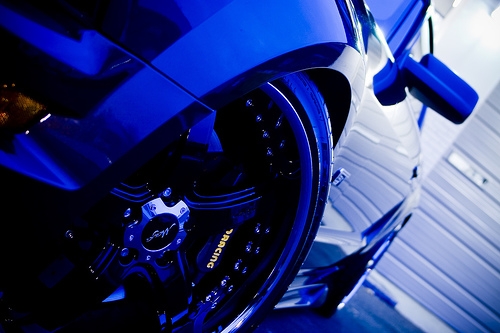
A car's braking system is one of its most important components. Good quality brakes are not only necessary for performance but also essential for safe driving. Brakes require occasional maintenance, including the replacement of brake pads, which are designed to wear down with use. Ceramic brake pads are an attractive alternative for many drivers to the OEM (original equipment manufacturer) pads that came on the car when it was new.
The use of ceramic brake pads is a relatively new phenomenon. For many years automakers offered new cars with brake pads that were either semi-metallic or composed of an asbestos-based compound. As health concerns grew around the use of asbestos, semi-metallic or low-metallic pads became the standard for most automakers. Ceramic and other materials were developed by aftermarket auto part manufacturers. Ceramic brake pads were first offered for Japanese cars in the 1990s and today are available for most makes and models of cars, trucks and SUVs.
Ceramic brake pads are composed mostly of ceramic fibers. These fibers, along with a small amount of metal, are held together with a bonding agent that gives the pads their structure. OEM brake mads are usually semi-metallic and contain various metals such as steel wool, shredded metal wire and iron powder. Other metals are used as well, along with a filler that bonds the metallic components together. Ceramic brake pads are softer and more consistent while semi-metallic pads are harder and contain more variations.
Despite different compositions, ceramic and OEM brake pads function in much the same way. Brake pads are used on disc brakes, which work by pinching a spinning metal rotor between two pads attached to a caliper. The caliper closes when the brake pedal is pressed, causing friction (and heat) between the pad and the rotor to slow or stop the vehicle. Most modern cars use disc brakes in the front wheels, where more stopping power is needed, while using less expensive drum brakes in the rear. Increasingly, automakers are offering cars with four-wheel disc brakes.
Ceramic and semi-metallic brake pads each have disadvantages that drivers should be aware of. Ceramic pads are softer and therefore wear down more quickly. They also cost more to replace. Semi-metallic brake pads are harder and therefore can cause the rotor itself to wear down more quickly. They also produce more noise, since the metal shards they contain will eventually come to the surface of the pad and come into contact with the spinning rotor. This noise will continue until the shard in the pad, or the rotor itself, is worn down sufficiently.
Both ceramic and semi-metallic OEM brake pads offer certain advantages over other types. Because they are soft, ceramic pads do not damage rotors and provide smooth, even friction during braking. Ceramic pads are also clean and produce less dust as they wear down. Semi-metallic pads offer the advantage of low cost, which is one of the main reasons they are used on most new vehicles. They also wear down slowly and provide good heat transfer away from the rotor. This helps prevent warping, which can occur when the rotor is exposed to excessive heat.